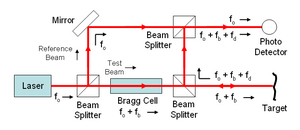
A laser Doppler vibrometer (LDV) is a scientific instrument that is used to make non-contact vibration measurements of a surface. The laser beam from the LDV is directed at the surface of interest, and the vibration amplitude and frequency are extracted from the Doppler shift of the reflected laser beam frequency due to the motion of the surface. The output of an LDV is generally a continuous analog voltage that is directly proportional to the target velocity component along the direction of the laser beam.
Some advantages of an LDV over similar measurement devices such as an accelerometer are that the LDV can be directed at targets that are difficult to access, or that may be too small or too hot to attach a physical transducer. Also, the LDV makes the vibration measurement without mass-loading the target, which is especially important for MEMS devices.